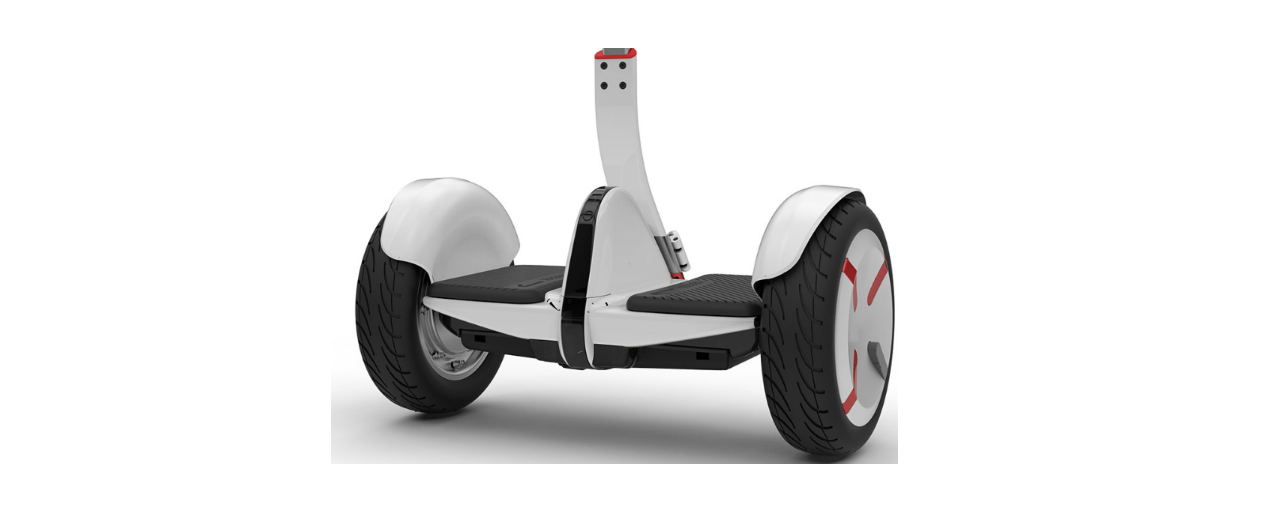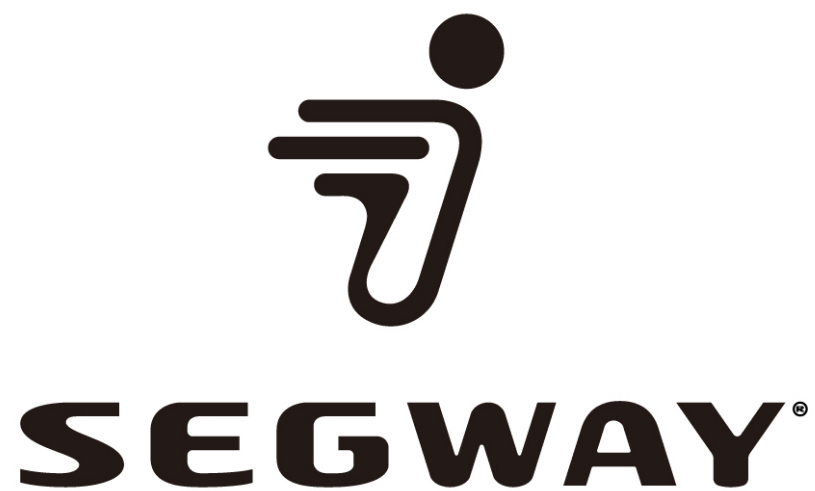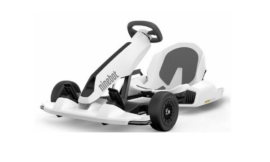Segway Ninebot Minipro N3M320 Balancing Transporter
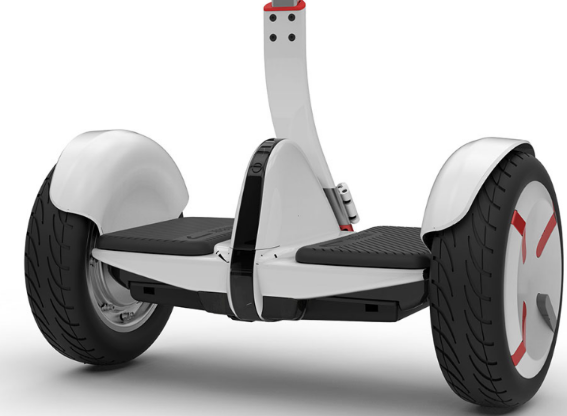
NOTE
You must first download the Ninebot by Segway App on your mobile device. The App will lead you through the New Rider Tutorial.
For your safety, the miniPRO will limit the max speed to 4.3 mph (7 km/h) until you have completed the New Rider Tutorial. After completing the New Rider Tutorial, the max speed will be limited to 6.2 mph (10 km/h) during the first 0.6 miles (1 km), after which you will be allowed to disable the speed limiter via the App and reach a max speed of 10 mph (16 km/h).
Thanks for choosing the miniPRO!
Thanks for choosing the Ninebot by Segway miniPRO (hereinafter referred to as miniPRO)! Your miniPRO is a revolutionary electric balancing vehicle featuring a mobile device application.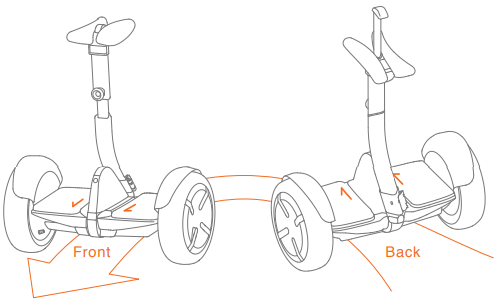
WARNING
Always step on/off from the back of the miniPRO. Otherwise, you risk falls and/or collisions because the steering direction is reversed.
Packing List
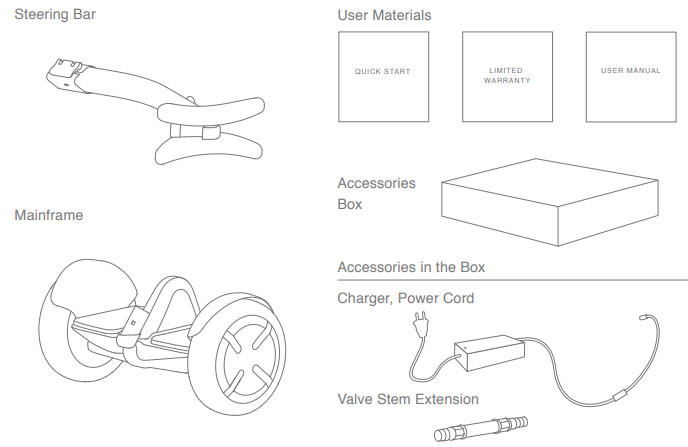
When unpacking your miniPRO, please verify that the above items are included in the package. If you are missing any components, please contact your dealer/distributor or email
technicalsupport@segway.com. After verifying that all components are present and in good condition, you can assemble your new miniPRO.
Please retain the box and packaging materials in case you need to ship your miniPRO. Remember to power off your miniPRO and unplug the charging cable before assembling, mounting accessories, or cleaning the mainframe.
Riding Safety
- The miniPRO is a recreational product, which is different from motor vehicles driven on the road. Before mastering riding skills, you need to practice. Neither Ninebot Inc. nor Segway Inc. is responsible for any injuries or damage caused by a rider’s inexperience or failure to follow the instructions in this document.
- Please understand that you can reduce the risk by following all the instructions and warnings in this manual, but you cannot eliminate all the risks. Remember that whenever you ride the miniPRO you risk injury or death from loss of control, collisions, and falls. When entering into public spaces always comply with the local laws and regulations. As with other vehicles, faster speeds require longer braking distances. Sudden braking on smooth surfaces could lead to wheel slip, loss of balance, or falls. Be cautious and always keep a safe distance between you and other people or vehicles when riding. Be alert and slow down when entering unfamiliar areas.
- Respect pedestrians by always yielding the right of way. Pass on the left whenever possible. When approaching a pedestrian from the front, stay to the right and slow down. Avoid startling pedestrians. When approaching from behind, announce yourself and slow down to walking speed when passing.
- In places without laws and regulations governing self-balancing electric vehicles, comply with the safety guidelines outlined in this manual. Neither Ninebot Inc. nor Segway Inc. is responsible for any property damage, personal injury/death, accidents, or legal disputes caused by violations of the safety instructions.
- Do not allow anyone to ride the miniPRO on his/her own unless they have carefully read this manual, watched the safety video, and followed the New Rider Tutorial on the Ninebot by Segway App. The safety of new riders is your responsibility. Spot new riders until they are comfortable with the basic operation of the miniPRO. Make sure each new rider wears a helmet and other protective gear.
- Before each ride check for loose fasteners, damaged components, and low tire pressure. If the miniPRO makes abnormal sounds or signals an alarm, immediately stop riding. Diagnose your miniPRO via the Ninebot by Segway App and call your dealer/distributor for service.
- Always wear a helmet when riding. Use an approved bicycle or skateboard helmet that fits properly with the chin strap in place, and protects the back of your head.
- Do not attempt your first ride in any area where you might encounter children, pedestrians, pets, vehicles, bicycles, or other obstacles and potential hazards.
- Be alert! Scan both far ahead and in front of your miniPRO — your eyes are your best tool for safely avoiding obstacles and low traction surfaces (including, but not limited to, wet ground, loose sand, loose gravel, and ice).
- To reduce the risk of injury, you must read and follow all “CAUTION” and “WARNING” notices in this document. Do not ride at an unsafe speed. Under no circumstance should you ride on roads with motor vehicles. Always follow these safety instructions:
The following people should not ride the Mini Pro:- Anyone under 16 years old or above 60 years old. Riders between 16-18 years old should ride under adult supervision.
- Anyone under the influence of alcohol or drugs.
- Anyone who suffers from a disease that puts them at risk if they engage in strenuous physical activity.
- Anyone who has problems with balance or with motor skills that would interfere with their ability to maintain balance.
- Anyone whose height or weight is outside the stated limits (see Specifications).
- Do not insert the power cord if the charge port is wet.
- Use a surge protector when charging to help protect your miniPRO from damage due to power surges and voltage spikes. Only use the Ninebot by Segway supplied charger. Do not use a charger from any other product.
- Use only Ninebot by Segway-approved parts and accessories. Do not modify your miniPRO. Modifications to your miniPRO could interfere with the operation of the miniPRO, could result in serious injury and/or damage, and could void the Limited Warranty.
- Do not sit on the steering bar. Doing so could result in serious injury and/or damage to your miniPRO.
Diagram
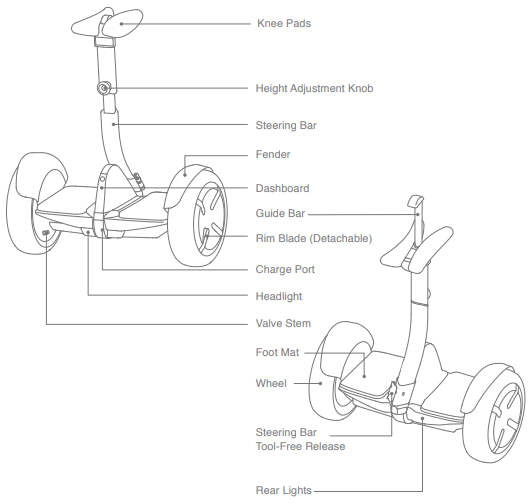
Dashboard Icons
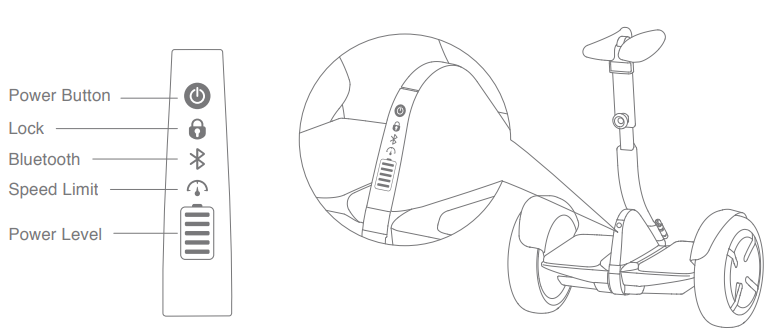
- Power Button
Turn ON/OFF. The miniPRO will automatically power OFF when idle for 10 minutes, or when laid down (horizontal) for over 30 seconds. - Lock
Enable Lock Mode via the App. The miniPRO will vibrate, flash its lights, and sound an alarm if anyone moves it. The App will also alarm. The mini pro will not balance in Lock Mode - Bluetooth
When Bluetooth is enabled but not connected to a smartphone, this icon will blink. When the Ninebot by Segway App is connected to the miniPRO, this icon will glow steadily. - Speed Limit
Enable and adjust Speed Limit Mode via the App. When the icon is illuminated the miniPRO is limited to 4.3 mph (7 km/h). This speed limit can be adjusted in the App. As you approach the speed limit, the miniPRO tilts back. - Power Level
Indicates the remaining battery life. When the battery is nearly empty this icon blinks and the miniPRO beeps, indicating that you need to charge your miniPRO. When less than 30%, your miniPRO will gradually reduce the max speed limit. Use the App to read the remaining power and estimated remaining range.
Assembling Your miniPRO
Install the steering bar
- Open the tool-free release as shown.
- Insert the steering bar into the mainframe steering socket.
- Close the tool-free release to secure.

Check the Power ON/OFF status after assembly.
Adjust the knee pad height

- Rotate height adjustment knob counter-clockwise.
- Lift the knee pads to the desired height. Rotate the height adjustment knob clockwise to tighten.
- Lift the guide bar to help steer the miniPRO without a rider when powered on. Do not use it to lift or carry the miniPRO.
First Ride
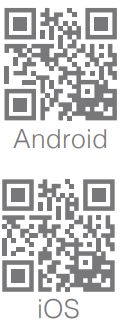
There are safety risks when learning to ride the miniPRO. You must read the Safety Instructions and follow the New Rider Tutorial in the Ninebot by Segway App before your first ride.
Go to www.segway.com to watch the safety video. Use your mobile device (Android or iOS) to install the Ninebot by Segway App, read the Safety Instructions, and then follow the New Rider Tutorial before your first ride. Go to the Apple App Store (iOS) or the Google Play Store (Android) and search for “Ninebot” to download and install the App.
Scan to download the App (iOS 8.0 or above, Android 4.3 or above)
When your miniPRO intermittently sounds an alarm, stop riding and check the App for details.

- Install the App and register/login
- Power ON the miniPRO. The Bluetooth icon blinking indicates the miniPRO is waiting for a connection.
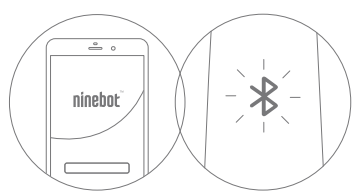
- Click “Search device” to connect to your miniPRO. The miniPRO will beep when the connection is successful. The Bluetooth icon will stop blinking and remain illuminated.
Follow the App instructions to learn how to ride safely. Have fun!
Charging
Do not connect the charger if the charge port or charge cable is wet.

Your miniPRO is fully charged when the LED on the charger changes from red (charging) to green (trickle charge).
Learning to Ride
WARNING
Rider must weigh 85–220 lbs (40–100 kg) and must be 4’3″–6’6″ (130–200 cm) tall. After activation, the App will lead you through the New Rider Tutorial. Please follow the instructions in the App and this manual.
NOTE
You must first download the Ninebot by Segway App on your mobile device. The App will lead you through the New Rider Tutorial.
Wear an approved helmet and other protective gear to minimize any possible injury

- Go to a large open area and ask a friend to assist you on your first ride.
- Place one foot on the foot mat, with your other foot still on the ground holding your weight. Do not press the steering bar with your leg.
- Slowly transfer your weight onto the miniPRO. The unit will beep, indicating it is now in balance mode. Slowly step on with your other foot.

- Stand with your weight evenly distributed on both feet and relax, looking straight ahead.
- Gently lean your body forward and backward to control your movement.
- To turn, gently lean left or right against the steering bar.
Lifting and Power Assist Mode

For your safety, motor power is cut off when the miniPRO is lifted off the ground in Balance Mode. When the miniPRO is put back down it will begin balancing again. Do not lift the miniPRO by the fenders or mainframe; you risk pinching or injuring your fingers/hands. Please lift via the steering bar as shown above.
Pull up the guide bar to enter Power Assist Mode (powered on, with no rider). Steer the miniPRO across smooth surfaces using the guide bar. Do not guide it upstairs across potholes, over large cracked/uneven surfaces, or other obstacles; guide your miniPRO around the obstacle or carry it over the obstacle as shown in the previous section.
Maintenance
Cleaning and Storing Your miniPRO
Use a soft, wet cloth to wipe the mainframe clean. Hard-to-remove dirt can be scrubbed with a toothbrush and toothpaste, and then cleaned with a soft, wet cloth. Scratches on plastic parts can be polished with extra fine grit abrasive paper.
NOTE
Do not wash your miniPRO with alcohol, gasoline, acetone, or other corrosive/volatile solvents. These substances may damage the appearance and internal structure of your miniPRO. Do not wash your miniPRO with a power washer or high-pressure hose.
Tire Pressure
Inflate tires to 45–50 psi. Inflate both tires equally.
Battery Pack Maintenance
Do not store or charge the battery at temperatures outside the stated limits (see Specifications). Do not discard or destroy the battery. For more battery information, refer to the sticker on the battery itself, located at the bottom of the miniPRO. Refer to your local laws and regulations regarding battery recycling and/or disposal.
A well-maintained battery can perform well even after many miles of riding. Charge the battery after each ride and avoid draining the battery completely. When used at room temperature (70°F [22°C]) the battery range and performance are at their best; whereas using it at temperatures below 32°F (0°C) can decrease range and performance. Typically, at -4°F (-20°C) range can be half that of the same battery at 70°F (22°C). Battery range will recover when temperature rises. More details are available in the App.
Specifications
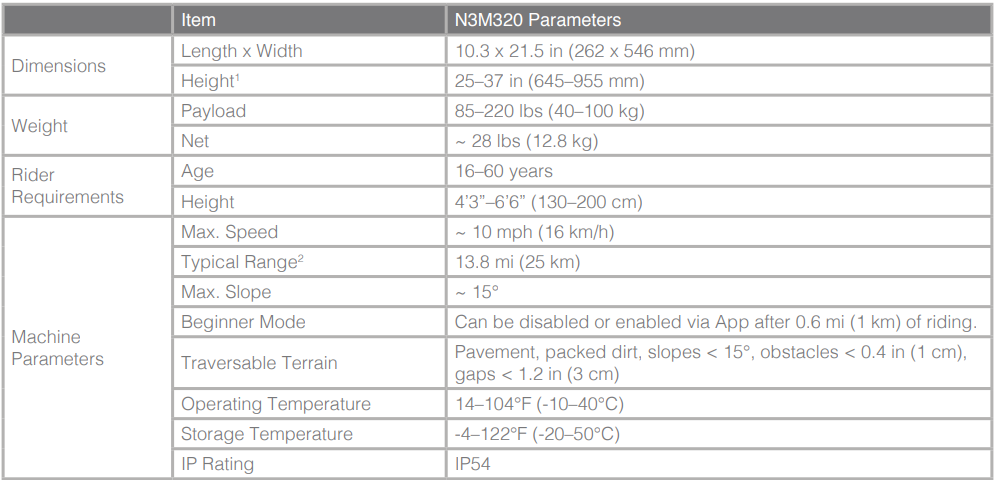

- Mainframe height: distance from the ground to the highest part of the mainframe.
- Typical Range: tested while riding under full power, 154 lbs (70 kg) load, 77°F (25°C), 9.3 mph (15 km/h) average speed on pavement.
- Continuous Discharge Power: tested while under full power at 77°F (25°C). The value changes with temperature and remaining battery capacity. For example, the continuous discharge power drops to ~80% of the maximum value at 10% remaining battery capacity, and the continuous discharge power drops to ~70% of the maximum value at 32°F (0°C).
Trademark and Legal Statement
Ninebot™ and the shape icon are trademarks of Ninebot Inc.; Segway® is the registered trademark of Segway Inc.; Ninebot by Segway™ is a trademark of Segway Inc.; iPhone and iOS, that of Apple Inc.; Android, that of Google Inc.
The respective owners reserve the rights of their trademarks referred to in this manual. Ninebot is the owner or licensee of various patents relating to Ninebot personal transportation robots, with other patents pending.
This manual is prepared by Ninebot who reserves all its copyrights. No institute or individual shall copy or disseminate this manual in whole or in part, or make use of the aforesaid patents without the consent of Ninebot in writing.
The miniPRO is covered by U.S. and foreign patents. For patent information go to http://www.segway.com. Ninebot (Tianjin) Technology Co. Ltd. manufactures and sells the miniPRO under a license from DEKA Products Limited Partnership.
Certifications
Safety
- Cells and battery pack have passed the UN/DOT38.3 test and certification
- 2014/35/EU: EN 60950-1:2006/A2:2013
- UL 60950-1, Ed. 2 (2007) + AM1 + AM2
- UL 1642
- UL 2272
EMC
- FCC part 15 subpart c
- FCC part 15.247
- 2014/30/EU: EN 61000-6-1:2007, EN 61000-6-3:2007/A1:2011
- 1995/5/EC: ETSI EN 300 328 V1.8.1 (2012-06); ETSI EN 301 489-1 V1.9.2 (2011-09); ETSI EN 301 489-17 V2.2.1 (2012-09)
- SAR: EN 62479:2010
FCC STATEMENT
This device complies with part 15 of the FCC Rules. Operation is subject to the following two conditions:
- This device may not cause harmful interference, and
- this device must accept any interference received, including interference that may cause undesired operation.
Note: This equipment has been tested and found to comply with the limits for a Class B digital device, under part 15 of the FCC Rules. These limits are designed to provide reasonable protection against harmful interference in a residential installation.
This equipment generates, uses, and can radiate radio frequency energy and, if not installed and used by the instructions, may cause harmful interference to radio communications. However, there is no guarantee that interference will not occur in a particular installation.
If this equipment does cause harmful interference to radio or television reception, which can be determined by turning the equipment off and on, the user is encouraged to try to correct the interference by one or more of the following measures:
- Reorient or relocate the receiving antenna.
- Increase the separation between the equipment and the receiver.
- Connect the equipment to an outlet on a circuit different from that to which the receiver is connected.
- Consult the dealer or an experienced radio/TV technician for help.
Contact
Contact us if you experience issues relating to riding, maintenance, and safety, or errors/faults with your miniPRO.
Segway Inc.
14 Technology Drive, Bedford, NH 03110
Tel: 1-603-222-6000
Fax: 1-603-222-6001
Toll Free: 1-866-473-4929
E-mail Sales: customeroperation@segway.com
E-mail Service: technicalsupport@segway.com
Website: www.segway.com
15 Certifications
Have your miniPRO’s serial number on hand when contacting Segway. You can find your serial number at the top of the steering bar between the knee pads or in the App under More Settings –> Basic Information.
For More Manuals by Segway, Visit LatestManuals
FAQs About Segway Ninebot Minipro N3M320 Balancing Transporter
How does Segway balance?
The Segway PT recognizes when the driver leans forward, just like the brain does. The car moves the wheels at precisely the correct speed to keep balance. The Segway PT can maintain balance on just two wheels because of a patented technology that the company refers to as “dynamic stabilization.”
Are segways hard to balance?
Because of their two wheels, some individuals may find segways frightening and question if they will be able to maintain their balance. However, learning to balance on a Segway is simpler than learning to balance on a bike or skateboard.
Is Segway self-balancing?
Dean Kamen created the two-wheeled, self-balancing Segway personal transporter.
What is the main purpose of the Segway?
You control the Segway, an electric scooter that balances on its own, by bending in the desired direction. In addition to commuters and law enforcement, it serves as a platform for mobile robots. Tour groups frequently use it.
Is a Segway easy to drive?
When your feet or legs suffer but you still want to travel, you’ll wish you had one. You’ll know without a doubt that a Segway is simple to ride after taking one out for the first time. Sure, riding a Segway is simple.
Why is my segway ninebot slow?
You’re using the light; because more power is required when using the light, the device may operate more slowly. You haven’t put it in “sport mode,” which is how we advise operating the Segway Es2 and Es4 scooters at all times. The speedometer will display a small red “S” if you are in sport mode.
What is cruise mode in Segway Ninebot?
Segway-Ninebot created a new cruising mode in response to customer concerns about children’s safety when riding kick scooters and their demand for exercise. Use your foot to initiate movement when the cruise mode is activated, and the sensor will measure the kick’s acceleration and maximum speed.
How does Segway keep balance?
The Segway recognizes when you are bending forward, much like your brain does. It moves the wheels at precisely the appropriate speed to maintain equilibrium, allowing you to advance.
Can everyone ride a Segway?
Let’s get ahead of ourselves and share a very important secret: practically anyone can ride a Segway. Yes, practically everyone. Well, if you’re not a dog, mermaid, or dolphin, you probably won’t have any problems using one. It is quite easy to ride a Segway; it is similar to riding a bicycle or scooter.
Do you need good balance to ride a Segway?
The Segway balances itself, so it doesn’t require good balance, which is precisely what makes it simple to operate! Leaning forward or backward is all that is required.

